On Monday, the National Highway Traffic Safety Administration (NHTSA) unveiled a set of new safety initiatives targeting large SUVs and pickup trucks, with the goal of reducing pedestrian deaths and potentially saving 67 lives annually.
The proposed rule will implement testing and performance benchmarks aimed at lowering pedestrian injury risks, with special attention to minimizing head injuries.
This initiative, part of the 2021 Bipartisan Infrastructure Law, involves using human-like dummies that simulate both children and adults. These dummies will be employed to assess the risk of head injuries from vehicle impacts in real-world scenarios.
While the rule covers passenger vehicles weighing up to 10,000 pounds, its primary focus is on the larger SUVs and pickups, which have seen significant increases in size and height over the years.
“We face a crisis on our roads, particularly affecting vulnerable users like pedestrians,” said NHTSA Deputy Administrator Sophie Shulman. “This proposed rule will push for vehicle designs that safeguard everyone on the road.”

Mario Tama/Getty Images
This proposal responds to alarming trends regarding the increasing size of SUVs and pickups, which have been connected to a rise in fatal pedestrian accidents.
Between 2013 and 2022, pedestrian fatalities jumped 57%, climbing from 4,779 to 7,522, according to NHTSA statistics. The agency’s plan aims to save 67 lives each year.
Data reveals that almost half of all fatal pedestrian accidents involve SUVs or trucks. In 2023, these vehicles accounted for nearly 79% of new vehicle sales, as per MotorIntelligence.com.
Research from the Insurance Institute for Highway Safety concurs that vehicles with taller and more upright fronts pose a greater risk to pedestrians. Vehicles like pickups and SUVs with hoods over 40 inches high are about 45% more likely to result in fatal pedestrian accidents compared to those with lower, sloping hoods.
Moreover, there are concerns about large pillars supporting the roofs of these vehicles, which may block drivers’ views of pedestrians, particularly at corners.
Consumer Reports published similar observations in 2021, noting an 11% increase in pickup truck hood heights since 2000. For example, in 2017, the Ford F-250 had a hood height of 55 inches, comparable to the roof of some cars. These elevated hoods create substantial blind spots, extending up to 11 feet further than those found in smaller sedans.
Automakers and industry representatives are currently invited to share feedback on the proposed rule. After a 60-day comment period, NHTSA will move forward with finalizing the regulation.
